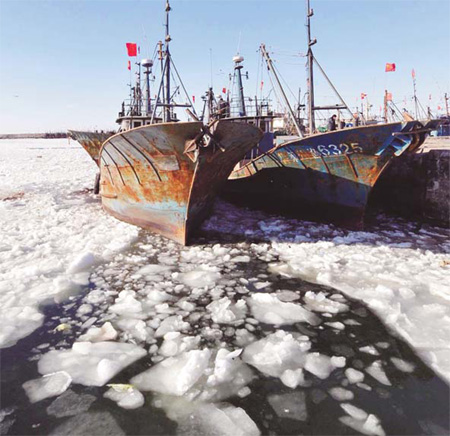Society
Warmer days to ease big freeze on the sea
Updated: 2011-02-01 08:20
By Cheng Yingqi (China Daily)
Western areas face more icy weather as rest of China thaws
 |
|
Floating ice surrounds ships at Sanshan Port in Laizhou Bay in the south Bohai Sea on Sunday. [Photo/Xinhua] |
BEIJING - Almost half of the Bohai Sea's surface is still covered by ice, although temperatures are rising in most parts of China, marine forecasters said.
About 47 percent of the sea is covered by ice, and floating ice now covers 37,000 square kilometers.
The freezing of the sea started in December 2010, affecting the Laizhou Bay in south Bohai Sea and resulting in the suspension of shipping services at Laizhou Port in Yantai, East China's Shandong province, since Jan 26.
"The sea ice has become even thicker here in Haimiaokou recently," said Li Liwei, an officer of the Haimiaokou police station in Yantai.
| ||||
"Although the sea freezes every year, I have never seen it so thick," Li said. "After all, Laizhou Port has never had to suspend shipping before."
Usually the sea ice appears as separate blocks floating in the water, but this winter it has turned into an ice table.
The sea surface close to river estuaries usually freezes in winter because there is less salt in those areas, according to Ding Zhixi, a spokesman for the Shandong provincial oceanic and fishery administration.
"The persistent cold snap this year has increased the amount of ice on the Yellow River, and this has affected the sea near (the river's estuary) at Laizhou Bay," Ding said.
The sea ice sweeping across the bay came from the Yellow River estuary, which is on the western side of the bay.
In Shandong province on Jan 23, 54 sections of rivers, including some 300 km of the Yellow River, were covered by ice that was 5 to 31 cm thick, according to the latest report of the local Yellow River authority.
However, the latest weather forecast said the Bohai Sea would see temperatures rise by 4 to 8 C from Monday.
"In such cases, the floating ice will disappear very quickly," Li, the police officer, told China Daily. Li said he once saw an ice layer 4 nautical miles wide vanish overnight.
At 4 pm on Sunday, the National Marine Environmental Forecasting Center downgraded the warning from level IV, and said that the situation is likely to ease from Monday to Wednesday.
But areas such as the Liaodong Bay in northeast Bohai Sea were still under a level IV warning.
Meanwhile, freezing rain will continue to fall in parts of western China, such as the eastern part of the Tibet autonomous region and Guizhou province. Snow will hit the Xinjiang Uygur autonomous region and Heilongjiang province. Most of the rest of China will experience warmer weather in the next three days, the China Meteorological Administration forecast on Monday.
Specials

Spring Festival
The Spring Festival is the most important traditional festival for family reunions.

Top 10
A summary of the major events both inside and outside China.

A role model
Alimjan Halik had been selected as the "Cyberspace Personality Who Moved the Hearts of the Chinese in 2010".


